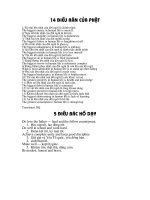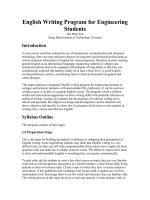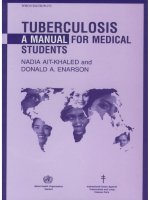Radiological Anatomy for Medical Student
Bạn đang xem bản rút gọn của tài liệu. Xem và tải ngay bản đầy đủ của tài liệu tại đây (2.22 MB, 84 trang )
Minimally Invasive
Surgery for Achilles Tendon
Disorders in Clinical Practice
Nicola Maffulli • Mark Easley
Editors
Minimally Invasive
Surgery for Achilles
Tendon Disorders
in Clinical Practice
Editors
Nicola Maffulli
Mile End Hospital
London
United Kingdom
Mark Easley
Duke Health Center
Durham
North Carolina
USA
Originally published as part of Minimally Invasive Surgery of the
Foot and Ankle (ISBN-978-1-84996-417-3) in 2011.
ISBN 978-1-4471-4497-7
ISBN 978-1-4471-4498-4
DOI 10.1007/978-1-4471-4498-4
Springer London Heidelberg New York Dordrecht
(eBook)
Library of Congress Control Number: 2012951635
© Springer-Verlag London 2013
This work is subject to copyright. All rights are reserved by the Publisher,
whether the whole or part of the material is concerned, specifically the rights
of translation, reprinting, reuse of illustrations, recitation, broadcasting,
reproduction on microfilms or in any other physical way, and transmission or
information storage and retrieval, electronic adaptation, computer software,
or by similar or dissimilar methodology now known or hereafter developed.
Exempted from this legal reservation are brief excerpts in connection with
reviews or scholarly analysis or material supplied specifically for the purpose
of being entered and executed on a computer system, for exclusive use by the
purchaser of the work. Duplication of this publication or parts thereof is
permitted only under the provisions of the Copyright Law of the Publisher’s
location, in its current version, and permission for use must always be obtained
from Springer. Permissions for use may be obtained through RightsLink at
the Copyright Clearance Center. Violations are liable to prosecution under
the respective Copyright Law.
The use of general descriptive names, registered names, trademarks, service
marks, etc. in this publication does not imply, even in the absence of a specific
statement, that such names are exempt from the relevant protective laws and
regulations and therefore free for general use.
While the advice and information in this book are believed to be true and
accurate at the date of publication, neither the authors nor the editors nor the
publisher can accept any legal responsibility for any errors or omissions that
may be made. The publisher makes no warranty, express or implied, with
respect to the material contained herein.
Printed on acid-free paper
Springer is part of Springer Science+Business Media (www.springer.com)
Preface
The tendo Achillis, the largest and strongest tendon in the
body, is the most frequently injured. Overuse and acute injuries
plague it, their management is complex, the results not guaranteed. A few things, however, hold true: there is not much
scientific evidence behind what we do, and there is much controversy about anything we do in this particular field. Also, the
rate of complications of traditional surgery is staggeringly high:
in the management of tendinopathy, traditional techniques
result in 10 % of patients experiencing a complication related
to skin healing. It is therefore not surprising that less invasive
techniques have been advocated. In this book, we illustrate the
most advanced minimally invasive techniques: they can be
hard to master, but they are for the benefit of the patients.
v
Contents
1
2
3
4
5
Endoscopic Assisted Percutaneous Achilles
Tendon Repair . . . . . . . . . . . . . . . . . . . . . . . . . . . . . . . . . .
Mahmut Nedim Doral, Murat Bozkurt,
Egemen Turhan, and Ozgür Ahmet Atay
1
Percutaneous Repair of Acute Achilles
Tendon Ruptures: The Maffulli Procedure . . . . . . . . .
Nicola Maffulli, Francesco Oliva, and Mario Ronga
15
Minimally Invasive Semitendinosus Tendon
Graft Augmentation for Reconstruction
of Chronic Tears of the Achilles Tendon . . . . . . . . . . .
Nicola Maffulli, Umile Giuseppe Longo,
Filippo Spiezia, and Vincenzo Denaro
25
Minimally Invasive Achilles Tendon
Reconstruction Using the Peroneus Brevis
Tendon Graft . . . . . . . . . . . . . . . . . . . . . . . . . . . . . . . . . . . .
Nicola Maffulli, Filippo Spiezia,
Umile Giuseppe Longo, and Vincenzo Denaro
35
Free Hamstrings Tendon Transfer and Interference
Screw Fixation for Less Invasive Reconstruction
of Chronic Avulsions of the Achilles Tendon . . . . . . .
Nicola Maffulli, Umile Giuseppe Longo,
Filippo Spiezia, and Vincenzo Denaro
45
vii
viii
6
7
Contents
Percutaneous Longitudinal Tenotomies
for Chronic Achilles Tendinopathy . . . . . . . . . . . . . . . .
J.S. Young, M.K. Sayana, V. Testa, F. Spiezia,
U.G. Longo, and Nicola Maffulli
Minimally Invasive Stripping for Chronic
Achilles Tendinopathy . . . . . . . . . . . . . . . . . . . . . . . . . . .
Nicola Maffulli, Umile Giuseppe Longo,
Chandrusekar Ramamurthy, and Vincenzo Denaro
Index . . . . . . . . . . . . . . . . . . . . . . . . . . . . . . . . . . . . . . . . . . . . . .
55
69
77
Chapter 1
Endoscopic Assisted
Percutaneous Achilles
Tendon Repair
Mahmut Nedim Doral, Murat Bozkurt, Egemen Turhan,
and Ozgür Ahmet Atay
The Achilles tendon is the strongest tendon in the human
body [1]. Hippocrates said “this tendon, if bruised or cut,
causes the most acute fevers, induces choking, deranges the
mind and at length brings death” [2]. Achilles tendon rupture
has been the focus of many studies since Ambroise Paré initially
M.N. Doral, M.D. ( )
Department of Orthopedics and Sports Medicine, Faculty of Medicine,
Hacettepe University, Sihhiye, Ankara 06100, Turkey
Sports Medicine Department, Hacettepe University,
Ankara, Turkey
e-mail: ,
M. Bozkurt
Department of Orthopedics and Traumatology,
Ankara Etlik Training Hospital, Ankara, Turkey
E. Turhan
Department of Orthopedics and Traumatology, Faculty of Medicine,
Karaelmas University, Zonguldak, Turkey
O.A. Atay
Department of Orthopedics and Sports Medicine,
Faculty of Medicine, Hacettepe University,
Sihhiye, Ankara 06100, Turkey
N. Maffulli, M. Easley (eds.), Minimally Invasive Surgery
for Achilles Tendon Disorders in Clinical Practice,
DOI 10.1007/978-1-4471-4498-4_1,
© Springer-Verlag London 2013
1
2
M.N. Doral et al.
described it in 1575 [3]. Achilles tendon ruptures are the third
most frequent major tendon ruptures, following rotator cuff
and quadriceps ruptures [4, 5]. Nevertheless, there is no consensus on the optimal management, and management is still
determined by the preferences of the surgeon and the patient.
Cast immobilization may lead to suboptimal healing, with
elongation of the tendon, reduced strength of the calf muscles,
and an unacceptably high rate of re-rupture [6–10].
Open surgical repair of the Achilles tendon carries specific
risks including adhesions between the tendon and the skin,
infection, and particularly wound breakdown [11–14].
Although Ma and Griffith introduced the percutaneous
repair technique to avoid these complications, percutaneous
repair may not achieve satisfactory contact of the tendon
stumps and adequate initial fixation [15]. In addition, sural
nerve entrapment is a reported complication of this technique [16, 17]. Only recently have safe and sound techniques
been developed, and some are described in other chapters of
this book by Prof Maffulli.
Percutaneous repair has become popular. The advantages
of the operative and conservative methods are combined in
minimally invasive percutaneous repair techniques, but these
techniques do not allow direct visualization of the tendon ends
(Fig. 1.1).This may be overcome by performing the percutaneous
repair under endoscopic control [18–27].
1.1 The Technique of Endoscopy
Assisted Percutaneous Repair
The operation is performed with the patients in prone position
with infiltration of local anesthesia in the area to be operated
on. No tourniquet is used, and we do not use antibiotic or antithrombotic prophylaxis. Before starting the procedure, the
rupture site is marked (Fig. 1.2). Then, to minimize local bleeding,
proximal (about 5 cm) and distal (about 4 cm) to the palpated
gap, the skin, subcutaneous tissues, and peritendon are infiltrated
with 20–50 mL 0.9 % saline solution with local anesthetic
Chapter 1. Endoscopic Percutaneous Achilles Tendon Repair
3
Figure 1.1 Greater dorsiflexion on the ruptured side than on the
healthy side
(1 % Citanest® 5 mL + 0.5 % Marcain® 5 mL) around the 8
planned stab wounds, 4 medial and 4 lateral to the tendon,
distributed evenly proximally and distal to the rupture (Fig. 1.3),
These stab wounds are later enlarged with the nick and spread
technique, and used for needle entry. Special attention is paid
to the area lateral to the Achilles tendon, especially proximally,
where the sural nerve lies close to and crosses the Achilles
tendon. The patient is prompted to report any paresthesiae or
pain in the area of distribution of the sural nerve at any time
4
M.N. Doral et al.
Figure 1.2 Palpation of the gap between the ruptured tendon ends
using an arthroscopic probe
Figure 1.3 Local anaesthetic injection to the subcutaneous tissues
from the stab incisions
Chapter 1. Endoscopic Percutaneous Achilles Tendon Repair
5
Figure 1.4 The placement of the arthroscope from distal medial incision
during the injection of local anaesthetic or during the procedure.
If this is experienced, the injection site is moved 0.5–1 cm
toward the midline. The injured foot is positioned in approximately 15° of plantar flexion. The tendon and paratenon are
examined with a 30º arthroscope (Smith-Nephew, London) via
the distal medial incision (Fig. 1.4). After the level of the rupture has been determined, the continuity of the surrounding
tissues together with their consistency and vascularization are
evaluated. The torn ends of the Achilles tendons are inspected,
and, if necessary, are manipulated within the paratenon. The
passing of the suture through the Achilles tendon is also controlled with the scope. We use an Ethibond No.5 or PDS No. 5
(Ethicon Inc, Johnson & Johnson, Somerville, NJ) suture with
a modified Bunnell configuration.
The needle with the PDS or Ethibond suture is first introduced through the upper medial portal (shown as ‘1’ in Fig. 1.5a).
The Achilles tendon is gently palpated between the thumb and
the index finger of the opposite hand to make sure that it is
caught fully by the needle. This first bite is a transverse one, and
the needle emerges from the upper lateral portal (shown as ‘2’
in Fig. 1.5a). The needle is then retrieved, introduced again
through it and passed through the upper lateral portal towards
portal 3. The procedure is repeated in a proximal to distal direction going from portal 3 to portal 4, from portal 4 to portal 5,
6
M.N. Doral et al.
a
b
c
Figure 1.5 (a, b) Schematic diagram of the percutaneous technique
(please refer to the text for details). (c) The sutures are tied with the
ankle in the neutral position
Chapter 1. Endoscopic Percutaneous Achilles Tendon Repair
7
from portal 5 to portal 6, from portal 6 to portal 7, and from
portal 7 to portal 8, the distal most lateral portal. At this point,
the needle is retrieved from portal 8, introduced through it and
passed through the distal most lateral portal towards portal 5,
and the procedure described above repeated backward in a
distal to proximal direction until the needle is finally returned to
the upper medial portal (shown as ‘1’ in Fig. 1.5b).
First, we pass the suture from the proximal medial incision
and out from the medial incision just above the ruptured tendon, making sure that the body of the proximal stump of the
tendon is squeezed between the thumb and index (Fig. 1.5a).
Second, we pass the suture from the same incision and out
from the lateral stab incision just above the tendon (Fig. 1.5a).
Finally, as in the first step, the suture is passed through this
stab incision and out from the distal medial side (Fig. 1.5a).
During suture passage, the arthroscope is placed alternatively in the various entry portals, and the Achilles tendon is
inspected from the medial and lateral aspects, and the proximal and distal stumps are inspected from proximal and distal
to make sure that the tendon stumps are juxtaposed. Also,
through the endoscope we make sure that the sutures are
introduced in the tendon at different levels on the coronal
plane, so that the chance of them cutting through during the
process of tensioning is minimized.
Finally, the sutures are tensioned, and tied in the proximal
medial entry portal with the ankle in neutral position whilst
checking the tendon approximation through the arthroscope.
Before tying the sutures with the ankle in neutral position,
the patient is instructed to actively dorsi- and plantar-flex the
ankle with the knee at 90° of flexion (Fig. 1.5c) to make sure
that appropriate tension is imparted to the suture. A final
check is performed, and the suture is knotted fully.
The skin stab incisions are closed with subcutaneous suture
and steristrips are used for initial dressing, and a walking brace
with the ankle in neutral is applied for at least 3 weeks (Fig. 1.6).
Immediate weight-bearing as tolerated with a walking
brace is initiated (for 3 weeks only), alternating with passive
range of motion exercises. Physiotherapy includes electrical
stimulation of the gastrosoleus complex; cryotherapy and
therapeutic ultrasound are applied around the Achilles tendon
8
M.N. Doral et al.
Figure 1.6 Final stab wound closure with steristrips
for reduction of edema. Transverse friction massage is used to
promote scar and tendon re-formation.
Patients are instructed to move the ankle four times a day
between 20º of plantar flexion and 10º of dorsiflexion. The
patients complete gentle isometric, eccentric and concentric
exercises of the ankle several times a day, with flexion and extension of the toes in a supine position, and full plantar flexion and
dorsiflexion of the ankle to neutral in a supine position; extension
of the knee in a sitting position; flexion of the knee in a prone
Chapter 1. Endoscopic Percutaneous Achilles Tendon Repair
9
position; and extension of the hip in a prone position within first
3 weeks. The walking brace is discontinued after 3 weeks. From
the sixth week to tenth week, rehabilitation progresses to using
elastic resistance bands; rotation of the ankles; standing on the
toes and heels; ankle stretching exercises to flexion with the help
of a rubber band; stretching of the calf muscle by standing with
the leg to be stretched straight behind and the other leg bent in
front and leaning the body forward, with support from a wall or
physiotherapist; stretching exercises for the toes and ankle
against manual resistance in a sitting position; balance and proprioception exercises on different surface progress from bilateral
to unilateral; controlled squats, lunges, bilateral calf raise (progressing to unilateral), toe raises, controlled slow eccentrics vs.
body-weight. After 10 weeks, patients start training jogging/running, jumping and eccentric loading exercises, non-competitive
sporting activities, sports-specific exercises, and return to physically demanding sports and/or work.
Rehabilitation process
0–3 weeks:
Range of motion: 20º of plantar flexion and 10º of
dorsiflexion
0–6 weeks:
Gentle isometric, eccentric and concentric exercises
with flexion and extension of the toes, full plantar
flexion and dorsiflexion of the ankle to neutral in
a supine position; extension of the knee in a sitting
position; flexion of the knee in a prone position;
and extension of the hip in a prone position
6–10 weeks:
Resistance exercises, rotation of the ankles;
standing on the toes and heels; ankle stretching
exercises for calf muscles, the toes and ankle,
balance and proprioception exercises on different
surface progress from bilateral to unilateral;
controlled squats, lunges, bilateral calf raise
(progressing to unilateral), toe raises, controlled
slow eccentrics vs. body-weight
10–↑ weeks:
Start training jogging/running, jumping and
eccentric loading exercises, non-competitive
sporting activities, sports-specific exercises, and
return to physically demanding sports and/or work
10
M.N. Doral et al.
Endoscopy-assisted percutaneous repair allows direct
observation of the process of suturing the Achilles tendon.
This eliminates some of the disadvantages of the percutaneous repair techniques, especially the evaluation of the juxtaposition of the torn ends [18, 30–32]. Endoscopy-assisted
percutaneous repair allows early active ankle mobilization
and weight bearing after a short period of cast immobilization and thereby, prevents complications due to the prolonged immobilization such as arthrofibrosis, joint stiffness,
calf atrophy, damage to the articular cartilage, and deep vein
thrombosis. Buchgraber and Pässler [28] compared the
results of immobilization and functional postoperative treatment after percutaneous repair of Achilles tendon rupture
and found that functional postoperative rehabilitation with
early weight-bearing was associated with significantly less
severe calf muscle work by the injured leg than postoperative
immobilization. Considering these advantages, endoscopyassisted percutaneous repair of AT may prevent some of the
negative issues associated with open, conservative, or percutaneous techniques. Also, this technique could help to prevent the risk of damage to the sural nerve by allowing its
direct visualization. However, we stress that knowledge of the
local anatomy is necessary to place the stab wounds in the
areas less likely to damage this nerve [29, 33].
In endoscopic repair, the paratenon is protected, providing
a biological advantage to the mechanical strength of the
repair furnished by the suture material. Also, preservation of
the paratenon decreases the gliding resistance of the extrasynovial tendons after repetitive motion in vitro [33]. Achilles
tendoscopy allows direct observation of the hematoma and
the stab wounds, and controlled juxtaposition of the tendon
ends without damaging the paratenon [34, 35].
Any technique may result in lengthening of the Achilles
tendon, possibly from not having closely approximated the
tendon ends. Carmont and Maffulli recommend a mini open
technique, with a 1.2–1.5 cm transverse incision at the level of
the rupture, to directly observe that appropriate juxtaposition of the ruptured tendon ends had been achieved [36].
Chapter 1. Endoscopic Percutaneous Achilles Tendon Repair
11
Figure 1.7 Bilaterally operated patient of AT rupture. Left side is
operated with percutaneous method and right side was operated
with open surgery previously. The appearance of the wound is cosmetic
with percutaneous method
Direct visualization of the tendon ends by endoscope through
the stab incisions allows this without any additional incision.
Obviously, the procedure requires experience in soft tissue
endoscopy. Percutaneous repair of the Achilles tendon under
endoscopic control results excellent wound appearance
(Fig. 1.7), This technique resulted in a cosmetic wound
appearance, endurable to early-active mobilization and satisfactory clinical recovery without any severe complication.
Furthermore, this procedure protects the paratenon, and
should enhance biologic recovery. Direct visualization and
12
M.N. Doral et al.
manipulation of the tendon ends also provide stable repair
that allows early weight-bearing and ambulation, and we
have used in athletic individuals. Percutaneous repair is likely
more cost effective than open techniques, and, in some settings, endoscopic control carries no additional costs [37].
Acknowledgement We would like to thank to Professor Nicola Maffulli
for his support and Dr. M. Ayvaz and Dr. G. Dönmez for archiving and
pictures.
References
1. Maffulli N. Rupture of the Achilles tendon. J Bone Joint Surg Am.
1999;81:1019–36.
2. Carden DG, Noble J, Chalmers J, et al. Rupture of the calcaneal
tendon. The early and late management. J Bone Joint Surg Br. 1987;
69:416–20.
3. Cetti R, Christensen SE, Ejsted R, et al. Operative versus nonoperative
treatment of Achilles tendon rupture. A prospective randomized
study and review of the literature. Am J Sports Med. 1993;21:791–9.
4. Hattrup SJ, Johnson KA. A review of ruptures of the Achilles tendon.
Foot Ankle. 1985;6(1):34–8.
5. Weiner AD, Lipscomb PR. Rupture of muscles and tendons. Minn
Med. 1956;39(11):731–6.
6. Edna TH. Non-operative treatment of Achilles tendon ruptures.
Acta Orthop Scand. 1980;51:991–3.
7. Fierro N, Sallis R. Achilles tendon rupture: is casting enough?
Postgrad Med. 1995;98:145–51.
8. Inglis AE, Scott WN, Sculco TP, et al. Ruptures of the tendo Achillis.
J Bone Joint Surg Am. 1976;58:990–3.
9. Jacobs D, Martens M, Van Audekercke R, et al. Comparison of
conservative and operative treatment of Achilles tendon ruptures.
Am J Sports Med. 1978;6:107–11.
10. Leppilahti J, Puranen J, Orava S. Incidence of Achilles tendon
rupture. Acta Orthop Scand. 1996;67:277–9.
11. Aoki M, Ogiwara N, Ohta T, Nabeta Y. Early active motion and
weightbearing after cross-stitch achilles tendon repair. Am J Sports
Med. 1998;26(6):794–800.
12. Bhandari M, Guyatt GH, Siddique F, et al. Treatment of acute
Achilles tendon ruptures a systematic overview and meta-analysis.
Clin Orthop. 2002;400:190–200.
13. Kangas J, Pajala A, Siira P, et al. Early functional treatment versus
early immobilization in tension of the musculotendinous unit after
Chapter 1. Endoscopic Percutaneous Achilles Tendon Repair
14.
15.
16.
17.
18.
19.
20.
21.
22.
23.
24.
25.
26.
27.
28.
29.
13
Achilles rupture repair: a prospective, randomized, clinical study.
J Trauma. 2003;54:1171–80.
Mortensen NHM, Skov O, Jensen PE. Early motion of the ankle
after operative treatment of a rupture of the Achilles tendon:
A prospective randomized clinical and radiographic study. J Bone
Joint Surg Am. 1999;81:983–90.
Ma GWC, Griffith TG. Percutaneous repair of acute closed ruptured
Achilles tendon. A new technique. Clin Orthop. 1977;128:247–55.
Klein W, Lang DM, Saleh M. The use of the Ma-Griffith technique
for percutaneous repair of fresh ruptured tendo Achillis. Chir
Organi Mov. 1991;76(3):223–8. English, Italian.
Rowley DI, Scotland TR. Rupture of the Achilles tendon treated by
a simple operative procedure. Injury. 1982;14(3):252–4.
Tang KL, Thermann H, Dai G, Chen GX, Guo L, Yang L. Arthroscopically assisted percutaneous repair of fresh closed Achilles tendon
rupture by Kessler’s suture. Am J Sports Med. 2007;35(4):589–96.
Thermann H, Tibesku CO, Mastrokalos DS, Pässler HH.
Endoscopically assisted percutaneous achilles tendon suture. Foot
Ankle Int. 2001;22(2):158–60.
Assal M, Jung M, Stern R, Rippstein P, Delmi M, Hoffmeyer P. Limited
open repair of Achilles tendon ruptures: a technique with a new
instrument and findings of a prospective multicenter study. J Bone
Joint Surg Am. 2002;84-A(2):161–70.
Barfred T. Experimental rupture of the Achilles tendon. Comparison
of various types of experimental rupture in rats. Acta Orthop Scand.
1971;42(6):528–43.
Kannus P, Józsa L. Histopathological changes preceding spontaneous
rupture of a tendon A controlled study of 891 patients. J Bone Joint
Surg Am. 1991;73(10):1507–25.
Inglis AE, Sculco TP. Surgical repair of ruptures of the tendo
Achillis. Clin Orthop Relat Res. 1981;156:160–9.
Kannus P. Etiology and pathophysiology of chronic tendon disorders
in sports. Scand J Med Sci Sports. 1997;7(2):78–85.
Zantop T, Tillmann B, Petersen W. Quantitative assessment of blood
vessels of the human Achilles tendon: an immunohistochemical
cadaver study. Arch Orthop Trauma Surg. 2003;123(9):501–4.
Nistor L. Surgical and non-surgical treatment of Achilles tendon
rupture. A prospective randomized study. J Bone Joint Surg Am.
1981;63:394–9.
Bradley JP, Tibone JE. Percutaneous and open surgical repairs of
Achilles tendon ruptures. Am J Sports Med. 1990;18:188–95.
Buchgrabber A, Pässler HH. Percutaneous repair of Achilles tendon
rupture. Immobilization versus functional postoperative treatment.
Clin Orthop. 1997;341:113–22.
Gorschewsky O, Vogel U, Schweizer A, et al. Percutaneous tenodesis
of the Achilles tendon. A new surgical method for the treatment of
14
30.
31.
32.
33.
34.
35.
36.
37.
M.N. Doral et al.
acute Achillis tendon rupture through percutaneous tenodesis.
Injury. 1999;30:315–21.
Halasi T, Tállay A, Berkes I. Percutaneous Achilles tendon repair
with and without endoscopic control. Knee Surg Sports Traumatol
Arthrosc. 2003;11(6):409–14.
Rebeccato A, Santini S, Salmaso G, Nogarin L. Repair of the achilles
tendon rupture: a functional comparison of three surgical techniques. J Foot Ankle Surg. 2001;40(4):188–94.
Webb JM, Bannister GC. Percutaneous repair of the ruptured tendo
Achillis. J Bone Joint Surg Br. 1999;81:877–80.
McClelland D, Maffulli N. Percutaneous repair of ruptured Achilles
tendon. J R Coll Surg Edinb. 2002;47(4):613–8.
Momose T, Amadio PC, Zobitz ME, Zhao C, An KN. Effect of
paratenon and repetitive motion on the gliding resistance of tendon
of extrasynovial origin. Clin Anat. 2002;15(3):199–205.
Doral MN, Tetik O, Atay OA, Leblebicioğlu G, Oznur A. Achilles
tendon diseases and its management. Acta Orthop Traumatol Turc.
2002;36 Suppl 1:42–6.
Carmont MR, Maffulli N. Modified percutaneous repair of ruptured
Achilles tendon. Knee Surg Sports Traumatol Arthrosc. 2008;16(2):
199–203.
Ebinesan AD, Sarai BS, Walley GD, Maffulli N. Conservative, open
or percutaneous repair for acute rupture of the Achilles tendon.
Disabil Rehabil. 2008;30(20):1721–5.
Chapter 2
Percutaneous Repair
of Acute Achilles Tendon
Ruptures: The Maffulli
Procedure
Nicola Maffulli, Francesco Oliva, and Mario Ronga
2.1
Introduction
The Achilles tendon (AT) is the strongest tendon in the
human body, but despite its strength, is the most frequently
ruptured tendon in the body. Ruptures usually occur between
2 and 6 cm of its insertion into the superior surface of the
calcaneus, a relatively hypovascular area [7, 17]. The major
N. Maffulli, M.D., M.S., Ph.D., FRCS (Orth) ( )
Centre for Sports and Exercise Medicine, Barts and The London
School of Medicine and Dentistry, Mile End Hospital, Queen Mary
University of London, 275 Bancroft Road, London E1 4DG, UK
Department of Trauma and Orthopaedic Surgery,
Keele University School of Medicine, University Hospital
of North Staffordshire Hartshill, Thornburrow Drive,
Stoke-on-Trent, Staffordshire, ST4 7QB, UK
e-mail:
F. Oliva, M.D., Ph.D.
Department of Trauma and Orthopaedic Surgery,
University’ of Rome “Tor Vergata”, Viale Oxford 81, Rome, Italy
M. Ronga, M.D.
Department of Orthopaedic and Trauma Surgery,
University of Insubria, Varese, Italy
N. Maffulli, M. Easley (eds.), Minimally Invasive Surgery
for Achilles Tendon Disorders in Clinical Practice,
DOI 10.1007/978-1-4471-4498-4_2,
© Springer-Verlag London 2013
15
16
N. Maffulli et al.
blood supply to tendons is from the mesotendon, and the
largest supply is from the anterior mesentery [2]. The tendon
is at the greatest risk of rupture when it is obliquely loaded,
the muscle is contracting maximally, and tendon length is
short [12]. This usually occurs as a result of pushing off with
the foot against resistance, and occurs most frequently in
males in their fourth decade.
The diagnosis of acute AT rupture is generally made clinically. There is usually a palpable defect in the AT. Patients will
often report that they felt as though they had been struck at
the back of the heel and may have heard a snapping sound.
They are usually unable to weight bear on the affected limb
because of pain and/or weakness. If some time has elapsed
since the rupture, the diagnosis can be more difficult, as the
gap fills in with edema and palpation is unreliable. Various
tests can be employed to aid diagnosis [11, 13, 14], such as calf
squeeze test [14], the Matles test can also be used [11]. and
the needle test. The neurovascular status of the limb should
be assessed, in particular the sensation over the distribution
of the sural nerve, and documented
Open surgical management of patients with ruptured ATs
allows accurate apposition of the ruptured tendon ends, earlier
motion, has a low risk of re-rupture, but is associated with a
significant rate of wound healing problems.
Advocates of minimally invasive AT surgery cite faster
recovery times, shorter hospital stays, and improved functional
outcomes as the principal reasons for adopting these new
approaches when compared to traditional open techniques.
In this chapter we describe a minimally invasive technique
to repair acute AT rupture.
2.2
Surgical Technique
The patient is positioned prone [3]. Areas 4–6 cm proximal
and distal to the palpable tendon defect and the skin over the
defect are infiltrated with 20 mL of 1 % Lignocaine. 10 mL of









